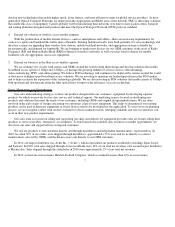Adaptec 2010 Annual Report Download - page 18
Download and view the complete annual report
Please find page 18 of the 2010 Adaptec annual report below. You can navigate through the pages in the report by either clicking on the pages listed below, or by using the keyword search tool below to find specific information within the annual report.
and our ability to resolve challenges associated with integrating acquired businesses into our existing business. These challenges
include integration of product lines, sales forces, customer lists and manufacturing facilities, development of expertise outside our
existing business, diversion of management time and resources, possible divestitures, inventory write-offs and other charges. We also
may be forced to replace key personnel who may leave our company as a result of an acquisition. We cannot be certain that we will
find suitable acquisition candidates or that we will be able to meet these challenges successfully. Acquisitions could also result in
customer dissatisfaction, performance problems with the acquired company, investment, or technology, the assumption of contingent
liabilities, or other unanticipated events or circumstances, any of which could harm our business. Consequently, we might not be
successful in integrating any acquired businesses, products or technologies and may not achieve anticipated revenues and cost
benefits.
An acquisition could absorb substantial cash resources, require us to incur or assume debt obligations, or issue additional equity.
If we are not able to obtain financing, then we may not be in a position to consummate acquisitions. If we issue equity securities in
connection with an acquisition, we may dilute our common stock with securities that have an equal or a senior interest in our
company.
From time to time, we license, or acquire, technology from third parties to incorporate into our products. Incorporating
technology into our products may be more costly or more difficult than expected, or require additional management attention
to achieve the desired functionality. The complexity of our products could result in unforeseen or undetected defects or bugs,
which could adversely affect the market acceptance of new products and damage our reputation with current or prospective
customers.
Our current product roadmap will, in part, be dependent on successful acquisition and integration of intellectual property cores
developed by third parties. If we experience difficulties in obtaining or integrating intellectual property from these third parties, it
could delay or prevent the development of our products in the future.
Although our customers, our suppliers and we rigorously test our products, our highly complex products may contain defects or
bugs. We have in the past experienced, and may in the future experience, defects and bugs in our products. If any of our products
contain defects or bugs, or have reliability, quality or compatibility problems that are significant to our customers, our reputation may
be damaged and customers may be reluctant to buy our products. This could materially and adversely affect our ability to retain
existing customers or attract new customers. In addition, these defects or bugs could interrupt or delay sales to our customers.
We may have to invest significant capital and other resources to alleviate problems with our products. If any of these problems
are not found until after we have commenced commercial production of a new product, we may be required to incur additional
development costs and product recall, repair or replacement costs. These problems may also result in claims against us by our
customers or others. In addition, these problems may divert our technical and other resources from other development efforts.
Moreover, we would likely lose or experience a delay in, market acceptance of the affected product or products, and we could lose
credibility with our current and prospective customers.
Industry consolidation may lead to increased competition and may harm our operating results.
There has been a trend toward industry consolidation in our markets for several years. We expect this trend to continue as
companies attempt to improve the leverage of growing research and development costs, strengthen or hold their market positions in
an evolving industry and as companies are acquired or are unable to continue operations. Companies that are strategic alliance
partners in some areas of our business may acquire or form alliances with our competitors, thereby reducing their business with us.
We believe that industry consolidation may result in stronger competitors that are better able to compete as sole-source vendors for
customers. This could lead to more variability in our operating results and could have a material adverse effect on our business,
operating results and financial condition.
17
























